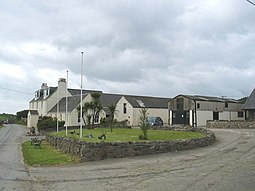| Scottish Gaelic name | Giogha[1] |
|---|---|
| Pronunciation | [ˈkʲi.ə] |
| Scots name | Gigha[2] |
| Old Norse name | Guðey[3] |
| Meaning of name | Old Norse, probably "God's island" or "good island" |
 Gigha Hotel | |
| Location | |
| OS grid reference | NR647498 |
| Coordinates | 55°41′N 5°45′W / 55.68°N 5.75°W |
| Physical geography | |
| Island group | Islay |
| Area | 1,395 ha (3,450 acres) |
| Area rank | 41[4] [5] |
| Highest elevation | Creag Bhàn 100 m (330 ft) |
| Administration | |
| Council area | Argyll and Bute |
| Country | Scotland |
| Sovereign state | United Kingdom |
| Demographics | |
| Population | 163[6] |
| Population rank | 37 [5] |
| Population density | 11.7/km2 (30/sq mi)[6][7] |
| Largest settlement | Ardminish |
| References | [8] |
Gigha (/ˈɡiːə/ GHEE-ə; Scottish Gaelic: Giogha; Scots: Gigha) or the Isle of Gigha[9] (and formerly Gigha Island)[10] is an island off the west coast of Kintyre in Scotland. The island forms part of Argyll and Bute and has a population of 163 people.[6] The climate is mild with higher than average sunshine hours and the soils are fertile. The main settlement is Ardminish.
Gigha has been inhabited continuously since prehistoric times. It may have had an important role during the Kingdom of Dalriada and is the ancestral home of Clan MacNeill. It fell under the control of the Norse and the Lords of the Isles before becoming incorporated into modern Scotland and saw a variety of conflicts during the medieval period.
The population of Gigha peaked at over 700 in the eighteenth century, but during the 20th century the island had numerous owners, which caused various problems in developing the island. By the beginning of the 21st century the population had fallen to 98. However a "community buy-out" in 2002 has transformed the island, which now has a growing population and a variety of new commercial activities to complement farming and tourism.
Attractions on the island include Achamore Gardens and the abundant wildlife, especially seabirds. There have been numerous shipwrecks on the surrounding rocks and skerries.
In 2021 the U.K. television broadcaster Channel 4 produced a reality show called Murder Island on the island, featuring a fictitious murder case written by the Scottish author Ian Rankin and “investigated” by ordinary members of the public, assisted by former police officers.
- ^ Mac an Tàilleir, Iain (2003) Ainmean-àite/Placenames. (pdf) Pàrlamaid na h-Alba. Retrieved 26 August 2012. This author specifies "God's island".
- ^ "Map of Scotland in Scots - Guide and gazetteer" (PDF).
- ^ Called such in Hákonar saga Hákonarsonar, § 328, line 8 Archived 2012-07-14 at archive.today, "Then King Hakon sailed south long Kintyre and lay at the place that is called Guðey" and § 329, line 7[dead link], "Then they went out under Guðey, to King Hakon"; see A. O. Anderson, Early Sources, vol. ii, pp. 617, 620
- ^ Haswell-Smith (2004) pp. 502–03. Modified to include bridged islands.
- ^ a b Area and population ranks: there are c. 300 islands over 20 ha in extent and 93 permanently inhabited islands were listed in the 2011 census.
- ^ a b c National Records of Scotland (15 August 2013). "Appendix 2: Population and households on Scotland's Inhabited Islands" (PDF). Statistical Bulletin: 2011 Census: First Results on Population and Household Estimates for Scotland Release 1C (Part Two) (PDF) (Report). SG/2013/126. Retrieved 14 August 2020.
- ^ Cite error: The named reference
HSmithwas invoked but never defined (see the help page). - ^ Infobox source is Haswell-Smith (2004) pp. 37–41 unless otherwise stated.
- ^ "Isle of Gigha/Giogha". Ordnance Survey. Retrieved 7 February 2019.
- ^ "Old Maps of Britain and Europe". A Vision of Britain through Time. Retrieved 4 May 2019.
